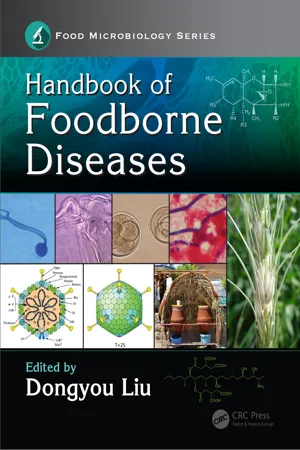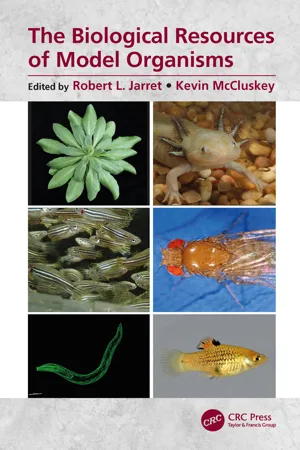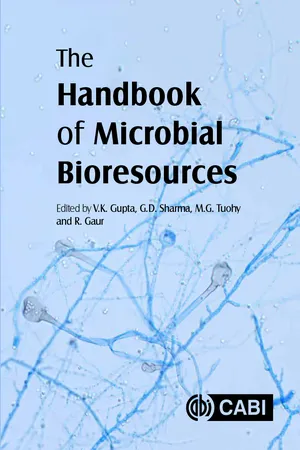Biological Sciences
Bacillus spp
"Bacillus spp" refers to a group of rod-shaped, Gram-positive bacteria commonly found in soil and water. They are known for their ability to form endospores, which allows them to survive harsh environmental conditions. Some species within this group are used in industrial and agricultural applications, while others can cause food spoilage and disease in humans and animals.
Written by Perlego with AI-assistance
Related key terms
6 Key excerpts on "Bacillus spp"
- eBook - ePub
- Dongyou Liu(Author)
- 2018(Publication Date)
- CRC Press(Publisher)
Part A: Gram-Positive Bacteria 15 Bacillus Dongyou LiuContents 15.1Introduction 15.2Classification, Morphology, Structure, and Genome 15.3Biology 15.4Epidemiology 15.5Clinical Features 15.6Pathogenesis 15.7Diagnosis 15.8Treatment 15.9Prevention 15.10Conclusion References15.1IntroductionThe genus Bacillus covers a very large group of gram-positive, rod-shaped bacteria capable of producing oval endospores under stressful environmental conditions, which are spore-like, dormant, tough, nonreproductive structures, with strong resistance to heat, cold, radiation, desiccation, and disinfectants.Being ubiquitous in soil and other environments, Bacillus species are largely free-living (nonparasitic) saprophytes that play a role in the maintenance of ecological systems. However, some Bacillus species are known to be pathogenic (parasitic) to humans and animals, the most important of which are B. anthracis (the agent of anthrax) and B. cereus (involved in food poisoning).Depending on the route of infection, B. anthracis may cause (1) cutaneous anthrax (or hide porter’s disease), with B. anthracis spores entering through cuts on the skin and manifesting as a boil-like skin lesion that eventually develops into a large, painless necrotic ulcer with a black center (eschar); (2) gastrointestinal anthrax due to consumption of anthrax-infected meat, and presenting with vomiting of blood, severe diarrhea, acute inflammation of the intestinal tract, and loss of appetite; and (3) pulmonary anthrax resulting from inhalation of B. anthracis spores, with initial infection in the lymph nodes in the chest (hemorrhagic mediastinitis), causing bloody fluid to accumulate in the chest cavity with fever, shortness of breath, cough, fatigue, and chills as main symptoms, and subsequent spread to the lungs, inducing symptoms of pneumonia (e.g., high fever, extreme shortness of breath, shock, and rapid death) [1 ].B. cereus - eBook - ePub
The Biological Resources of Model Organisms
Collection, Characterization and Applications
- Robert L. Jarret, Kevin McCluskey(Authors)
- 2019(Publication Date)
- CRC Press(Publisher)
1973). More than four decades later, despite the revolution ushered in by recent technological and theoretical advances in biology, the definition remains essentially the same: Bacillus bacteria have cells that are “rod‐shaped, straight or slightly curved, occurring singly and in pairs, some in chains, and occasionally as long filaments. Endospores are formed, no more than one to a cell; these spores are very resistant to many adverse conditions” (Logan and De Vos 2015). This definition, while accurate for the purposes of taxonomy, needs to be placed in a much larger framework. Endospores are far more than a morphological feature or taxonomic trait. They are the centerpiece of a diverse range of developmental options, many of them requiring a remarkable degree of multicellular cooperation, which have allowed these bacteria to survive and thrive on a global scale (Figure 3.1). Most isolates of the genus Bacillus and its closest phylogenetic relatives have simple nutritional requirements. Under ideal conditions, they proliferate rapidly, dividing by binary fission. Generation times for many species may be as short as a half hour or less in the laboratory (Zeigler, unpublished observations). In nature, however, conditions approximating the ideal occur only sporadically. When a population of Bacillus experiences nutrient depletion and enters stationary phase, several subpopulations emerge, each pursuing a different developmental path (Figure 3.1). This suite of options has been seen as a bet-hedging strategy, increasing the likelihood that at least part of the population survives the environmental challenge (Norman et al. 2015, Veening et al. 2008b). In B. subtilis cultures, for example, subpopulations of motile single cells and sessile chains quickly appear (Mukherjee and Kearns 2014). The motile cells may be able to locate microenvironments that are more favorable for growth - eBook - ePub
- Karen C. Carroll, Michael A. Pfaller, Marie Louise Landry, Alexander J. McAdam, Robin Patel, Sandra S. Richter, David W. Warnock(Authors)
- 2019(Publication Date)
- ASM Press(Publisher)
B. toyonensis.Other clinically important genera of aerobic endospore-forming organisms are phenotypically similar to the Bacillus, but some differences do exist. Geobacillus species are obligately thermophilic and Geobacillus stearothermophilus (formerly Bacillus stearothermophilus) is commonly employed as a biological indicator for laboratory quality control activities (e.g., for monitoring autoclave efficacy and the sporicidal activity of disinfectants). Lysinibacillus species are distinguished by the composition of the cell wall peptidoglycan, which is rich in lysine and aspartic acid. Lysinibacillus sphaericus (formerly Bacillus sphaericus) occasionally causes opportunistic infections in human hosts but is best known for its insecticidal toxin, which has been commercialized for use in mosquito control programs (3 , 4 ).Paenibacillus and Brevibacillus cultures may stain Gram positive but are more likely to be Gram negative or Gram variable, and sporangia usually have a swollen appearance. Paenibacillus is the type genus of the family Paenibacillaceae and includes species originally defined by 16S rRNA gene sequencing as Bacillus “rRNA group 3” (5 ). The majority of species are of environmental origin. These include nitrogen-fixing organisms associated with plant roots and insect pathogens used for biocontrol applications. Paenibacillus species have been isolated from a variety of clinical sources, including blood, cerebrospinal fluid (CSF), wounds, and urine (6 –8 - eBook - ePub
- Vincent A. Fischetti, Richard P. Novick, Joseph J. Ferretti, Daniel A. Portnoy, Mirian Braunstein, Julian I. Rood(Authors)
- 2019(Publication Date)
- ASM Press(Publisher)
Bacillus cereus Group: Bacillus Species with Pathogenic Potential Monika Ehling-Schulz, Didier Lereclus and Theresa M. Koehler 55TAXONOMY: HISTORICAL AND SOCIOECONOMIC ASPECTS
The microorganisms constituting the Bacillus cereus group are Gram-positive low-GC-content bacteria belonging to the phylum Firmicutes . The group of spore-forming, aerobic, facultative anaerobic, rod-shaped bacteria comprises at least eight closely related species: B. anthracis , B. cereus , B. thuringiensis , B. mycoides , B. pseudomycoides , B. weihenstephanensis , B. cytotoxicus , and B. toyonensis (1 ). With the exception of B. cytotoxicus , which is the most divergent of the group, with a chromosome of 4.085 Mb (2 ), the genomes of the B. cereus group species are highly conserved, with sizes of 5.2- to 5.9-Mb and very similar 16S rRNA gene sequences.The definition of these species and the distribution of the strains within them were based on phenotypes and their clinical and economic significance and mainly associated with plasmid content (3 , 4 ). B. anthracis harbors two plasmids, pXO1 (182 kb) and pXO2 (95 kb), carrying the structural genes for the toxin proteins and the biosynthetic genes for capsule formation, respectively (5 ). The emetic B. cereus strains harbor plasmid pCER270, encoding enzymatic components required for the nonribosomal biosynthesis of the toxin cereulide (6 , 7 ). B. thuringiensis harbors several plasmids encoding a large variety of the insecticidal toxins Cry and Cyt, which form the parasporal crystal characteristic of the species (8 –10 ). The other five species are discriminated by morphological or physiological traits. B. mycoides and B. pseudomycoides have typical rhizoid growth (11 , 12 ). B. weihenstephanensis strains are psychrotolerant. Like the mostly mesophilic members of the B. cereus group, the optimal growth temperature for B. weihenstephanensis is between 25 and 35°C, but the species is distinguished by its ability to grow at temperatures as low as 4°C (13 ). On the other hand, B. cytotoxicus strains are thermotolerant and can grow in up to 50°C (14 ). Finally, B. toyonensis was characterized for probiotic properties and is used as such in animal feed (15 - eBook - ePub
- Vijai Kumar Gupta, Gauri Dutt Sharma, Maria G Tuohy, Rajeeva Gaur(Authors)
- 2016(Publication Date)
- CAB International(Publisher)
2012 ). The first group includes free-living microorganisms that specifically interact with plants under favourable conditions. The second group is rhizospheric and phylospheric species localized in soil zones adjacent to roots or on the epidermal surface of plant leaves that can hardly exist without a host. The third group is bacteria that are able to form stable associations with certain tissues and organs of plants by penetrating into them through the intercellular space (endophytes). Many representatives of the third PGPR group cannot exist for long without a host and lose their ‘useful’ properties.One of the most attractive objects for industrial (commercial) production of biopesticides, including those that are actively used in farming practice, is Bacillus spp. strains (Jetiyanon and Kloepper, 2002 ; Chakraborty et al., 2006 ; Siddiqui, 2006). Some strains of Bacillus spp. are capable of inactivating mycotoxins, have biocide activity against plant bacterial and fungal pathogens, can induce the plant defence system, and are used both as effective probiotics and as an alternative to pesticides. The endophytic property of some Bacillus strains allows them to escape from the competitive pressure of other species of saprotrophic rhizobacteria because they occupy the intercellular space of plant tissues. Indeed, several commercial products based on various species of Bacillus (e.g. Bacillus amyloliquefaciens, Bacillus licheniformis, Bacillus pumilus and Bacillus subtilis) have been marketed as biofungicides (Table 4.1 ).Table 4.1. Strains of Bacillus spp. used as biopesticides for biological control of plant disease.Recently Bacillus (Brevibacillus) laterosporus BPM3 with highly insecticidal activity has been shown to exert antagonistic activity towards phytopathogenic fungi, such as Fusarium oxysporium f. sp. cicero, Fusarium semitectum, Magnaporthe grisea and Rhizoctonia oryzae and Gram-positive bacterium Staphylococcus aureus. In greenhouse conditions B. laterosporus was used to control rice blast disease, caused by M. grisea, and was able to reduce disease incidence by 30–67% (Saikia et al., 2011 - eBook - ePub
- Frans J. de Bruijn(Author)
- 2015(Publication Date)
- Wiley-Blackwell(Publisher)
Paenibacillus occur abundantly in most rhizosphere soils and plant tissues and are differently colonized by distinct subpopulations (Mahaffee and Kloepper, 1997; Seldin et al., 1998).Members of the Paenibacillus genus are widely distributed in nature and have diverse physiological characteristics. At present, there are 141 Paenibacillus species [http://www.bacterio.cict.fr/p/paenibacillus.html ], including 21 species having nitrogen-fixing ability: P. polymyxa (Grau and Wilson, 1962), P. macerans, P. durus, and P. peoriae (Montefusco et al., 1993), P. borealis (Elo et al., 2001), P. graminis and P. odorifer (Berge et al., 2002), P. brasilensis (von der Weid et al., 2002), P. massiliensis (Roux and Raoult, 2004), P. wynnii (Rodríguez-Dias et al., 2005), P. sabinae (Ma et al., 2007a), P. zanthoxyli (Ma et al., 2007b), P. donghaensis (Choi et al., 2008), P. forsythiae (Ma and Chen, 2008), P. sonchi (Hong et al., 2009), P. riograndensis (Beneduzi et al., 2010), P. sophorae (Jin et al., 2011a), P. jilunlii (Jin et al., 2011b), P. beijingensis (Gao et al., 2012), P. brassicae (Gao et al., 1993), and P. taohuashanense (Xie et al., 2012). This genus harbors strains of industrial and agricultural importance. Some of these organisms excrete diverse assortments of extracellular polysaccharide enzymes to hydrolyze complex carbohydrates (Shida et al., 1997), such as glucanotransferase, chitinase, amylase, cellobiohydrolase, agarase, cellulose, and proteases (Aguilera et al., 2001; Sakiyama et al., 2001; Alvarez et al., 2006; Aktuganov et al., 2008; Moon et al., 2011). A number of Paenibacillus
Learn about this page
Index pages curate the most relevant extracts from our library of academic textbooks. They’ve been created using an in-house natural language model (NLM), each adding context and meaning to key research topics.





